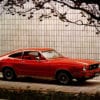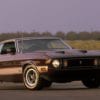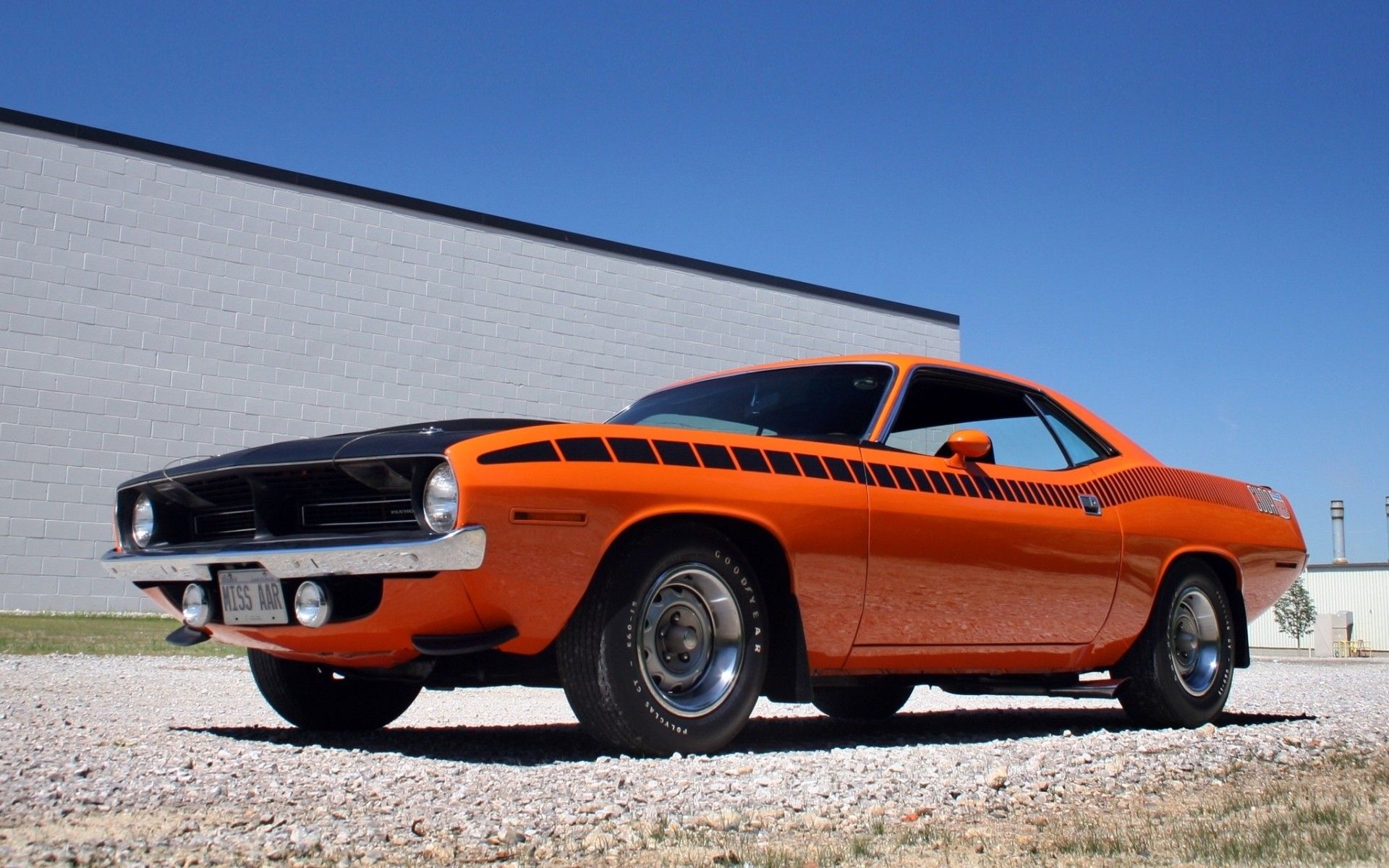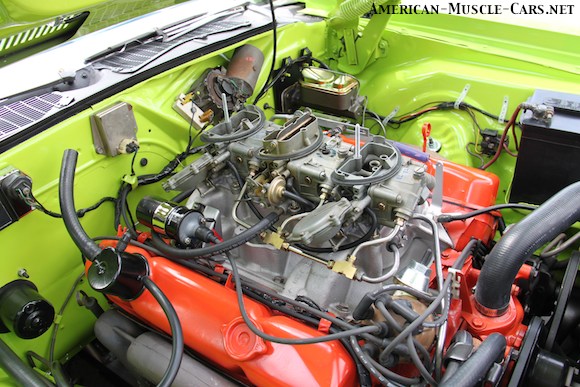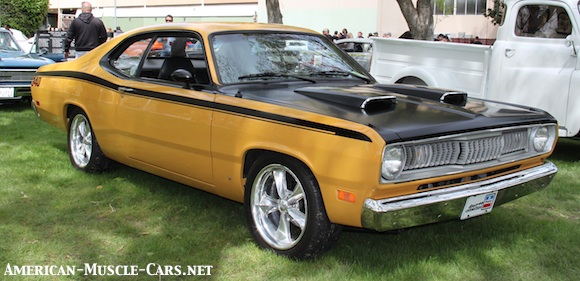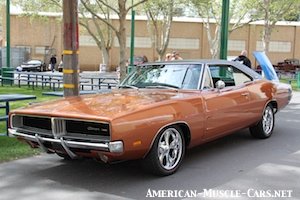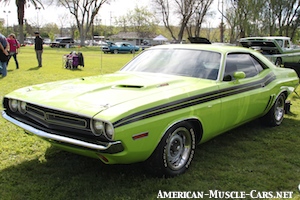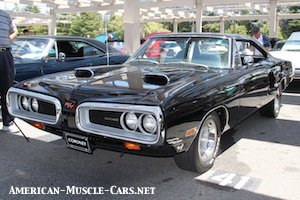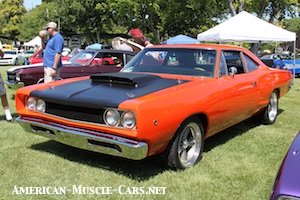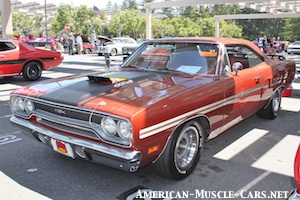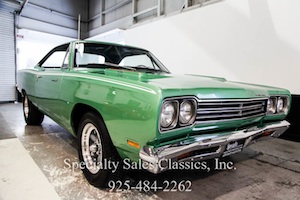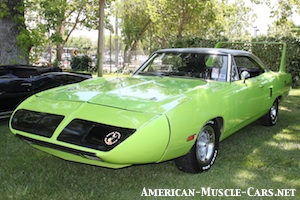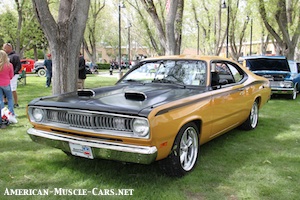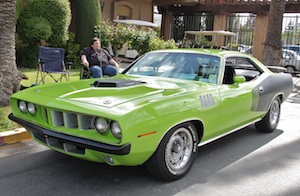Mopar Muscle Cars
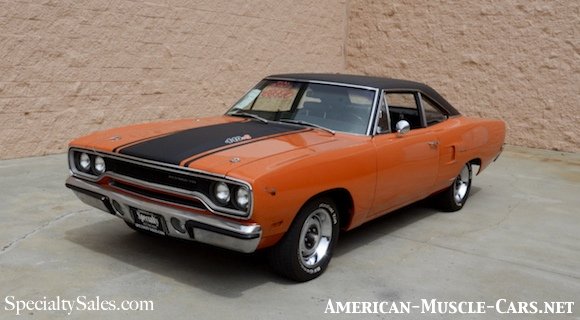
One of the great Mopar Muscle Cars, this 1970 Plymouth Roadrunner came with 440/6-pack. The quintessential muscle car with a bigass engine.
MOPAR: LONG ON ENGINEERING, SHORT ON LOOKS
Mopar (derived from the words ‘motor’ and ‘parts’) refers to any car, muscle car or otherwise, that was built by the Chrysler Corporation, or any of its subsidiary brands, including Dodge, Chrysler and Plymouth (Desoto, Imperial, etc.). And Chrysler has always been very strong on engineering. Things like torsion-bar suspension, and hemi-head engines were unheard of in the 1950s, but Chrysler did it routinely. They were so anal about their engineering that they used right-hand-threaded lug nuts on the left side of the car, and left-hand-threaded lug nuts on the right, to exploit the wheels’ natural torque to continuously tighten the lugs. All this attention to mechanical detail helped them build some great cars with a reputation for quality, durability, power and reliability. One of the fastest production cars you could buy in the 1950s was a full-sized Chrysler 300 with Hemi power. Mopar knew how to build fast cars.
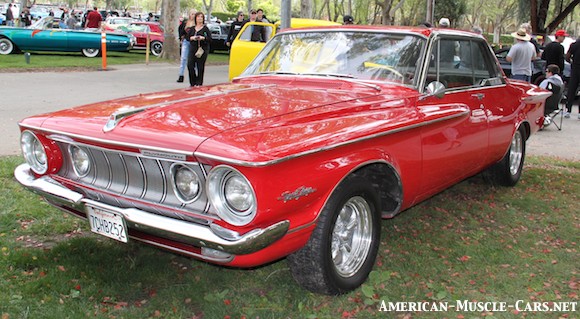
CLASSIC MOPAR MUSCLE CARS
NOT JUST ANOTHER PRETTY FACE
The problem with classic Mopar muscle cars, and Chrysler’s products in general in the late 1950s and early 1960s, was they they just weren’t all that good-looking. Even the awesome Chrysler 300 was homely to look at. As the Big-Fin Age faded into obscurity, it was replaced by the boxy shapes of the early 1960s. Mopar’s cars were, by and large, boxier than either Ford’s or GM’s offerings, and looked stodgy by comparison. As the American Muscle Car Wars heated up, GM fired the first volley (the 1964 Pontiac GTO), Ford responded quickly with hotted-up Fairlanes (and of course the Mustang which isn’t technically a ‘muscle car’), and Chevrolet with the Chevelle SS. While Mopar had the ‘muscle’, their cars didn’t have the looks of the Ford or GM offerings. But, they did the best they could with what they had. Their Muscle Cars would be heavy on the muscle, and that sort of made of for the looks.
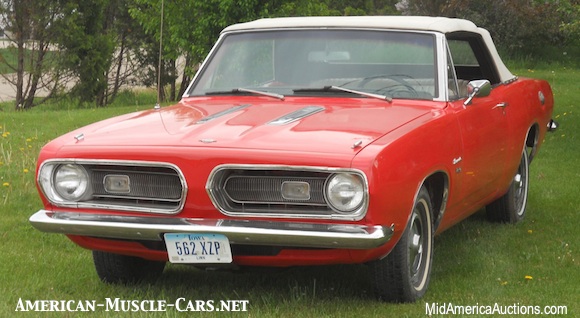
MOPAR MUSCLE CARS: BARRACUDA BEFORE & AFTER
ABOVE: This is what the Plymouth Barracuda looked like in 1968, and pretty much the same in ’69. The first two generations of Barracuda were based on the humble Plymouth Valiant.
BELOW: This is what the Barracuda turned into in 1970, along with its stablemate, the Dodge Challenger. For the first time, these were purpose-built Pony Cars, not warmed over economy cars. Unfortunately, by the time they introduced them in 1970, the Muscle Car era was peaking and would never come back (well…not until now).
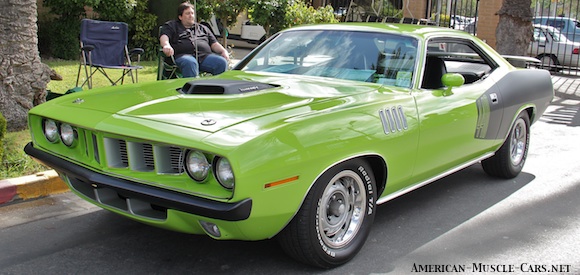
CLASSIC MOPAR MUSCLE CARS
LAST TO THE PONY CAR PARTY
The one missing piece of the puzzle in Mopar’s line of high-performance cars was the Pony Car. The Pony Car Boom started the same year the Muscle Car Era began, with the 1964-1/2 Ford Mustang, and it’s never let up, not to this day. Ford sold over 300,000 Mustangs the first year and everyone else in the business wanted a piece of the pie. The other 3 car companies (including AMC along with Fomoco and GM) were all scrambling to come out with a product that would tap into that rich new vein known as “the youth market”. It took GM fully 3 model years to respond, but what a response. The 1967 Chevrolet Camaro and 1967 Pontiac Firebird rewrote the book on Pony Cars, bigger and nicer than the spartan little 1964-66 Ford Mustang, just as Ford decided the same thing and enlarged the Mustang for 1967 and gave it more comfort features. AMC (American Motors) was next to the party with their 1968 AMC Javelin. Dodge and Plymouths only offerings were all based on mid-sized passenger cars, and weren’t in direct competition with this new style of Sport GT. It took until 1970 for them to finally get it together, but boy when they did, they really nailed it! The 1970-74 Dodge Challenger, and Plymouth Barracuda were regarded by many as the ultimate Pony Car, well ahead of the Mustang and Camaro/Firebird twins, when it was introduced in 1970. Alas, just as it came out, the first Muscle Car Era had peaked and was drawing to a close. It was downhill from there. But, among all the Pony Cars bought and sold in auction these days, some of the most popular and valuable are Dodge Challengers and Plymouth Barracudas. Of course Dodge has begun producing a new version of the classic Challenger and did a bang-up job of it.
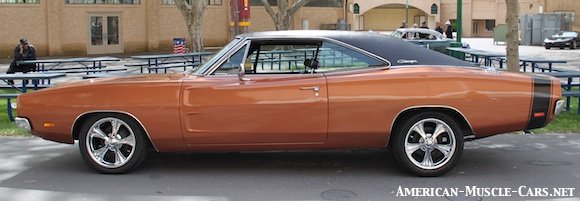
ABOVE: This 1969 Dodge Charger shows that “Coke bottle-shape” that made this very big car look svelte.
MOPAR MUSCLE CARS THROUGH THE 60’s
Dodge was leading the charge with the Dodge Charger (above), the Super Bee (a tarted-up Coronet and sister car to the Plymouth Roadrunner. But the king of Dodge muscle cars had to be the Challenger, actually a Pony Car, but packing such muscle that it could run with the best of them. Let’s not forget about Plymouth however. Chrysler had always positioned Plymouth to be their lower-priced brand, selling stripped-down versions of Dodge cars. They continued this tradition with their muscle cars by morphing the lowly Plymouth Valiant into the first (unfortunately rather ugly) Barracuda, their midsized Belvedere into the macho Roadrunner, which itself butched-up into the upscale GTX. In all, Plymouth was really cashing in working the lower end of the muscle car market, and producing some dynamite cars in the process. The irony is that many of them were loaded up with options that pushed their price right up to where Dodge and the other players were strongest. But who cared? It was the 60’s, right?
BELOW: 1970 Dodge Challenger R/T convertible.
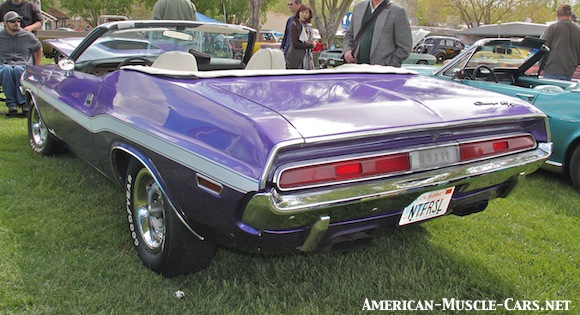
MOPAR MUSCLE CAR ENGINES
Mopar had some of the best engines of the era. High-winding 273, 318 and 340 small blocks, 383 and 440 Magnum big blocks, and at the top of the heap, the mighty “Elephant Motor”, the 426 Hemi. Two 4-barrels? Mopar offered them from the factory! Three 2-barrels? Yep, got those too. No one else was doing stuff like this in 1970. Below is a 440/6-pack out of a ’70 Cuda.
ABOVE: 1971 Plymouth Duster.
MOPAR MUSCLE CARS IN THE 70’s
Like everyone else, Mopar got hit hard with emissions, fuel consumption and safety regs. The days of the Muscle Car peaked in 1970 and ended by 1973. But Dodge and Plymouth continued to soldier on, doing what they could. Horsepower was down, but “personal luxury” was on the rise. By the late 70s, it was all but over for Chrysler in terms of performance, then they made a wholesale move over to front-wheel drive with the K-car platform, and that was the end of Mopar Muscle Cars until much, much later. But that’s another story…
BELOW: 1972 Plymouth Roadrunner, bigger and more luxurious, that was the direction the whole muscle car market was headed.

CLASSIC MOPAR MUSCLE CARS
CARVING OUT A NICHE
The scrappy engineers at Chrysler quickly adapted existing designs, however humble, in an effort to capitalize on some of the new “American Muscle Car” boom kicked off by the 1964 Pontiac GTO. In response, the lowly 1964 Plymouth Valiant (not a great-looking car to start with) grew an ungainly fastback rearend treatment with an enormous wraparound back window, and became the Plymouth Barracuda. A couple years later in 1966, Dodge did the same thing to their Coronet (a boxy, vanilla mid-size car) to create the first-generation Dodge Charger. But, help was on the way. By about 1968, Mopar was getting its mojo going with one hit after another, and again, all based on more plebeian donor cars. The Plymouth Belvedere got a big engine, some styling changes & a set of trick wheels and tires and voila! We have the Plymouth Road Runner, complete with trademark ”Meep Meep” horn (licensed along with the Road Runner name and character from Warner Brothers cartoons). Dodge created 2 cars out of the Dodge Coronet. The 1968 Dodge Superbee looked very similar to it’s Coronet roots, but way cooler, and way faster. It also bowed again as the 1968 Dodge Charger, but this time with completely new, Coke-bottle-shaped bodywork that was an instant hit. Things just kept getting better and better for classic Mopar Muscle Cars in the late 1960s. They had the cars, and they certainly had the muscle. Big block 383 and 440 Magnums were among the strongest engines of the Muscle Car Era, with a few notable exceptions, the most notable of which was Mopar’s own 426 Hemi. So as the 1960s drew to a close, classic Mopar Muscle Cars were on the top of the heap, in terms of power and performance, looks and desirability, even if they never nearly matched the huge production numbers of Ford and General Motors. Perhaps that’s part of what makes them so sought after today by collectors.
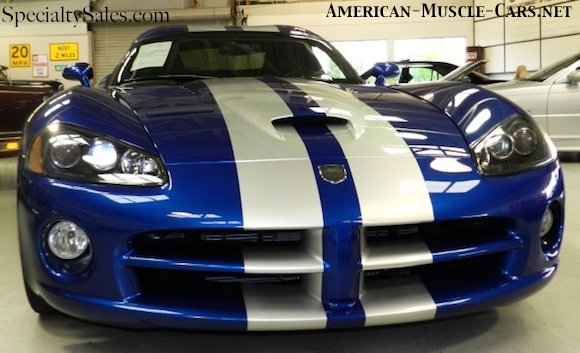
ABOVE: This 2006 Dodge Viper is part of the 3rd- of 5-generations of these V10-powered monsters. Lauded at the ‘modern-day Cobra’ by some. It will go out of production in 2017.
THE VIPER: MOPAR MUSCLE CARS ARE BACK!
Mopar spent decades building boring front-drive cars, although some of the turbo models were pretty fast for their day, especially the ones that Carroll Shelby breathed on as part of a deal he had with Chrysler. His influence also touched off a brave new project that no one would have ever throught would get off the ground: the 1992 Dodge Viper. Those mad scientists in Mopar’s Frankenstein laboratory did it again. This time, they stretched a 360 small block V8 into an 8-liter V10 and dropped it into a car that looked like a schoolboy fantasy. Okay, so it sounded like a Hoover vacuum cleaner, it was hard to get in and out of, you couldn’t see out of it, the AC couldn’t keep up with the engine heat boiling up through the floor, and you burned your leg on the pipes every other day. But Lordy it was fast!!! Dodge practically hand-built them so they never sold in great numbers. But their impact on the world was much greater than mere production numbers. The Viper signaled to the world that Dodge was back…with a vengeance!
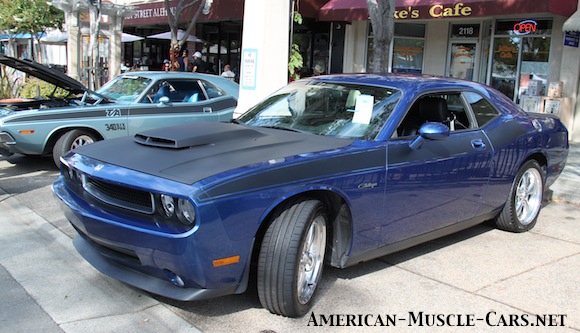
ABOVE: This 2010 Challenger R/T is owned by the same buy who owns that ’70 Challenger T/A in the background.
CHALLENGER: THE OLD ONE-TWO PUNCH
Dodge wasn’t done yet, not by a long shot. Maybe the only good thing that Chrysler got out of its brief and unfortunate marriage to Mercedes Benz was the platform (from the 2003-09 W211 Mercedes E-class) that has underpinned every rear-drive car it’s built since. Chrysler’s highly-successful 300 is built on this chassis, as was the Dodge Magnum, and now the Dodge Charger and Challenger. Dodge also came out with the 3rd-generation of its legendary Hemi V8, and just like in the old days, they have not hesitated to hop it up past the point of all common sense and reason. The new Charger and Challenger Hellcats have supercharged 6.2-liter Hemis that generate 707 horsepower, making the Charger the most powerful 4-door production car in the world. Typical of Mopar to pull something like this off. Daring. Edgy. They even revived many of those wild old paint colors with the crazy names (Plum Crazy, Sub Lime, et al). I never thought I’d say this, but there has never been a better time for a muscle car nut to be alive!
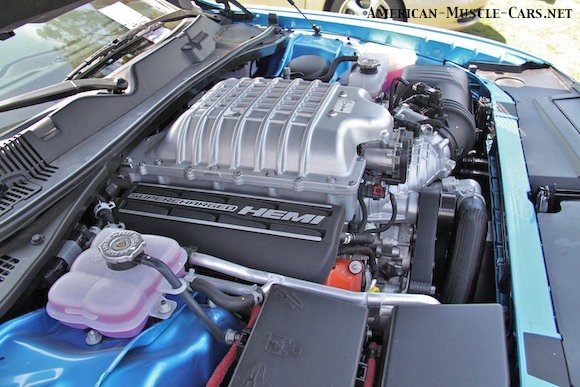
ABOVE: The supercharged 6.2L Hemi, seen here in a 2016 Challenger Hellcat.
HELLCAT: THOSE DODGE BOYS ARE AT IT AGAIN!
Just like in the good ol’ days, Dodge is pushing the boundaries of performance and common sense. In 1970, it was a 426 Hemi with two 4-barrels in a 3,200-pound B-body. Today it’s the 707-horsepower Hellcat. Available in both the Challenger and Charger. It takes a supercharged 6.2-liter Hemi to make that kind of power, making the Charger the world’s most powerful production 4-door. The Challenger Hellcat is really more of a straight-line drag monster than a track car. Times have never been so good for horsepower junkies.
Mopar Muscle Cars MODEL-BY-MODEL
There was a time when it seemed like “The Dodge Boys” could do just about anything. And they often did, from wild colors to cartoon characters, all to the soundtrack of screaming Hemis.
Spun off the Coronet, Dodge’s big burly GT was a major hit, and the R/Ts were quite fast in their own right. And they had a lot of style.
One of the most iconic muscle cars of all times, Dodge’s Pony Car kicked serious ass. Big block & Hemi power optional.
Dodge’s workhorse B-body was not only the basis for the Charger & Super Bee, in R/T trim, it was one heckuva Muscle Car in its own right. 440 Six-Pack & 426 Hemi optional.
Built from the Coronet, the name came from it being a Super B-Body car. The cartoon character soon followed.
This was Performance: 1970s-style…or maybe Muscle Car Lite. Built on a smaller, lighter compact chassis, the top engine choices were small block V8s. No big blocks here.
Plymouth built some of the most outstanding muscle cars of the era, the Roadrunner, Barracuda & GTX, to name a few.
Plymouth’s top-of-the-line muscle car, spun off the Roadrunner, which itself morphed from the lowly Belvedere. Somehow Plymouth always found a way to make them cool…and fast, don’t forget about fast!
Based on the Belvedere platform, with special trim, beefed up suspension and of course big, fire-breathing engines, the Roadrunner “Meep-Meeped” it’s way into muscle car history.
When the boxy aerodynamics of the Roadrunner became a problem on the NASCAR track, Plymouth grafted on a slippery new nose & huge rear wing, creating a winner & an instant classic! A few were sold to the public for homologation.
A decidedly ’70’s Mopar Muscle Car, with small block power, the top engine being a 340.
Perhaps the ultimate Pony Car, born at the end of the Muscle Car Era. But what a car! Sister to the Dodge Challenger, it was red hot back then, and still sought after by collectors today.


